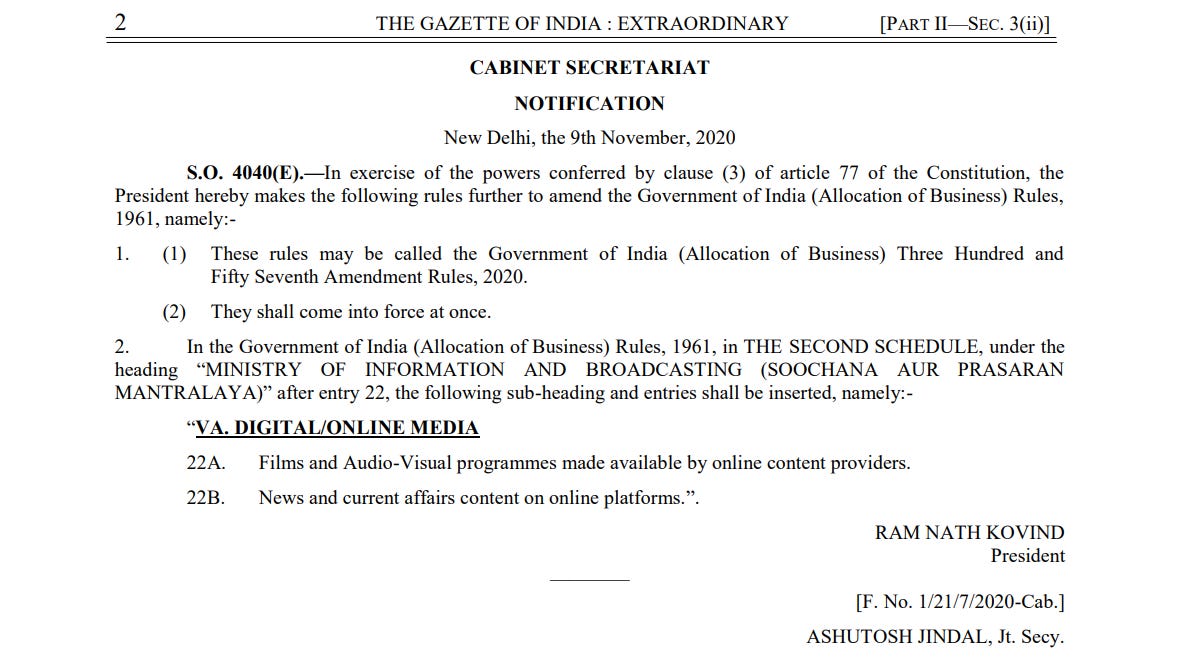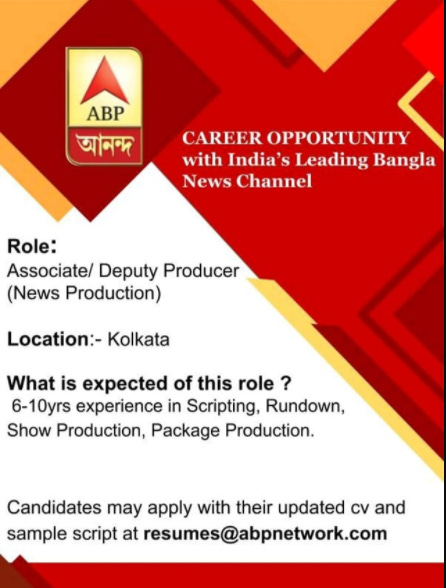The Ministry of Information & Broadcasting (MIB) will now have OTT platforms and online platforms streaming news and current affairs under its purview, thanks to the gazette notification issued on 11 November 2020, duly signed by President Ram Nath Kovind.

So far, the online/digital content space has largely remained self-regulated with no law or autonomous body regulating it. But with this move, the Central Government is likely to change the way we know online content. OTT platforms and online portals are speculating long-term—arguably, damaging—effects.
Online platforms have been able to create content largely free of censorship that enabled them to touch upon sensitive content that would never make it to television or the theatres. But with this amendment to Government of India (Allocation of Business Rules) 1961, that might become a challenge.
The online/digital media, before this gazette, was governed by the Ministry of Electronics & Information Technology (MEITY), which looked over the whole digital space without employing regulations. And that’s the reason MIB has been on the lookout to transfer the jurisdiction of online content from MEITY to itself since earlier this year, as digital media is the only unregulated one out of the five media.
“First came the print media, so we had the Press Council of India. Then we had All India Radio, there we had a different structure. FM radio is not permitted to air news other than that of AIR. Television developed on a different line altogether. In TV there is no pre-censorship, there is a regulatory structure that comes in after content has aired. Films require prior certification from the CBFC. For five different media, four are having different regulatory practices; they are either self-regulated, pre-regulated, post-regulated, and one of them [OTT] is unregulated,” Amit Khare, the secretary of the Ministry of I&B noted.
The tussle, rife with debates and disagreements, has been on since 2018. The following Twitter thread by Nikhil Pahwa, the founder of MediaNama, encompasses the timeline with context.
One of the important points that differentiate broadcasting from online streaming, while also making it strange for the digital content to come under MIB’s domain is well summarised by Nikhil here:
Seemingly triggered by the ongoing dialogue since 2018, entities in their own capacity began taking actions. For instance, in January 2019, eight video streaming services together made a self-regulatory code. Five types of content were prohibited, according to this report by The Hindu. The government refused to accept it.
A further iteration of the same code was signed on 5 February 2020, which was signed by just four entities (out of the previous set of signatories) at the Internet and Mobile Association of India’s (IAMAI) annual digital summit.
While OTT platforms were trying to band together, in late October 2020, 11 Indian digital news organisations joined hands under a group called Digipub News India Foundation. The 11 signatories are Alt News, Article 14, Boomlive, Cobrapost, HW News, Newsclick, Newslaundry, Scroll.in, News Minute, The Quint and The Wire. According to their press release, “DIGIPUB News India Foundation has been created to represent, amplify and evolve best practices to build a robust digital news ecology that is truly world-class, independent and upholds the highest standards of journalism,” reported The Wire.
Two weeks after Digipub is formalised, Central Government’s gazette notification takes a step further towards regulating online news organisations. This is Digipub’s statement in response to the government’s new rule:
After all these steps, this is what Minister of Home Affairs Amit Shah tweeted on 16 November 2020, on National Press Day:
With a lot at stake, dissent between stakeholders, and contradictory statements by the government and its officials, it’s a tricky situation. Like always, we guess, we’ll have to wait and watch.

How to Live Your Best YouTube Life?
We could go on and on about how to make your YouTube channel (or your publication’s YouTube channel) work. Unlike many other video publishing platforms, YouTube growth is steady and feels fairly logical. But be careful! That doesn’t mean it’s easy to monetise on YouTube, or that you’ll get thousands of followers easily. It requires a lot of work. But there are quite a few things you can do on YouTube to try and boost the number of eyeballs that will end up on your page. This will work best if you’re consistent with your publishing schedule. If you’re not, you’re unlikely to see much growth.

Here are a few basic tips:
- Make the most of your title (aka, Search Engine Optimisation): When you’re coming up with a title, think about what someone will put in the YouTube search bar when they’re trying to find something to watch. In a breaking news situation, you can use Google Trends to help you find what keywords people are most searching for and work those searches into your title.
- What you need to include in your description: Including the keywords from your title in your description is important for your SEO. Make sure you repeat them in your description and make sure your description is at least 80 words long. Your video won’t get ranked on Google News if the description is too short.
- Why you should include subtitles: Even if your audio is clear and in the language your target audience speaks, it’s always a good idea to add subtitles. Why? First and foremost, it makes your content available to people who are hard of hearing or deaf. You also have the added benefit that your audience can watch your content without the sound on. This is especially relevant for videos on social media platforms like Facebook and Instagram, but it also applies to YouTube. Especially if someone is sneakily trying to watch a video during a meeting. We’ll share a tutorial for easy subtitling soon.
- End Screens, Annotations and Cards: YouTube gives you the chance to link to other channels, websites, playlists and videos. So why miss an opportunity to let whoever is watching the video know about other places they can see your work? Linking to other videos you’ve done can help you boost views on your older work.

Week 2 led the fellows to advanced editing application: Kinemaster. While last week was about putting photos and texts together in a linear timeline, Kinemaster upped that to layered editing. Both the sessions (English and Hindi) took the attendees through each and every function of the app, and the trainers explained the nuances of a gripping video through a storyboard, that they recommended being prepared ahead of any journalistic assignment.
A lot of our fellows have been creating videos using Canva, Quik and now Kinemaster, which we’ll keep sharing in our Instagram stories. Aditya Ojha, one of our fellows, is also regularly publishing news packages using Quik on his YouTube channel.
Also this week, our fellowship partner Internews is running FactShala Training-of-Trainer Program on fake news and misinformation between 24-26 November. This program aims to train grassroots journalists and common people to become misinformation warriors who will further train tier two and three city residents and persons from rural areas in this domain.

ABP Bangla is hiring.
Share your updated CV and sample script at resumes@abpnetwork.com

Aaj Tak Radio is hiring.
Aaj Tak Radio is looking for an audio/sound engineer to edit, mix and work on a variety of podcasts. Candidates with both audio and video editing skills will be given priority.
Responsibilities: Editing and mixing podcasts, promo production and fixing audio-related issues. This person will closely work with podcast producers and deliver projects to their specifications. Good editorial sense and interest in podcasting will be a plus.
Work Experience: 0 - 2 years
Please share your CVs along with work samples to aajtakradiojobs@gmail.com
Article 14 is hiring.
A resource person to liaise with reporters and social organisations.
Responsibilities: The work will involve coordinating with partners for field verification of data and events, that feeds into published stories, commissioned reports, and research we are undertaking in collaboration with institutions or academics. The resource person should be able to identify field partners at the state, district or taluka level, and cultivate and sustain relationships with them. The work may be sensitive and deadline-driven, and therefore requires high levels of trust, efficiency and responsiveness. Experience in coordination and management would be an asset.
Job Type: We will accept applicants interested in both full-time and part-time employment.
Remuneration: We will pay Rs. 35,000, negotiable based on experience, qualification and time commitment.
Please direct your questions and applications to reacharticle14@gmail.com. Applicants must include their resume and a short statement of interest.
The Quint is hiring.
- Gaon Connection is hiring.
Ungender is hiring.
Ungender is hiring for a Communications and Social Media role.
Experience: We're looking at someone with 5-8 years of experience with an active knowledge of Internet culture, social media trends, community, gender, and feminism. Someone who has a love for online communication and networking and has a working knowledge of design tools, including Canva and video editing.
How to Apply: Please get in touch with Rituparna Chatterjee if you are interested.
Twitter: @masalabai
ABOUT THIS NEWSLETTER
This newsletter is an attempt to keep up and share all the latest and greatest stories in media and how they get done. Read about it here: About In Old News-Letter
And if you were forwarded this newsletter, here’s how you can sign up to get the latest editions as they come out!
